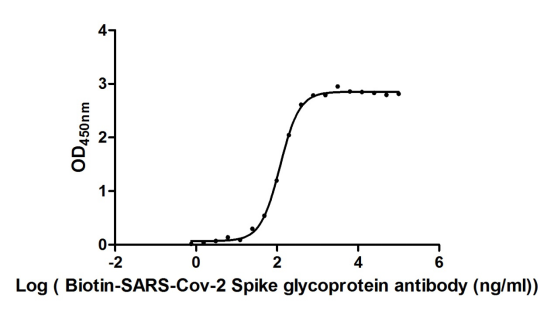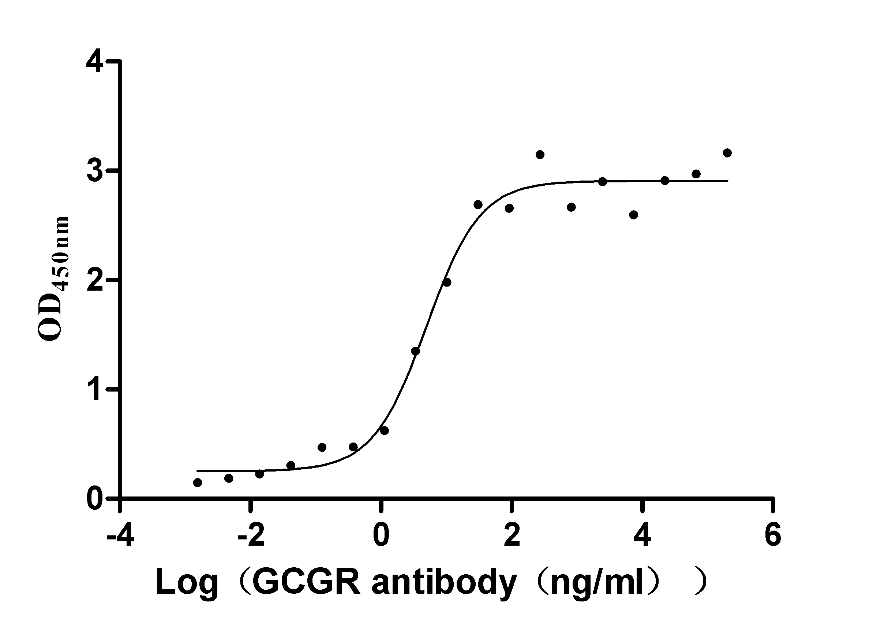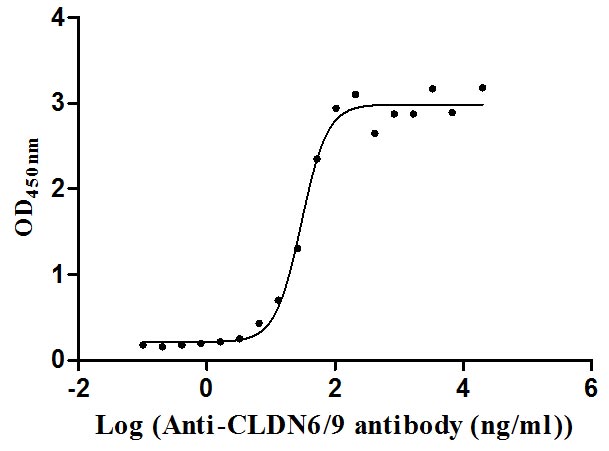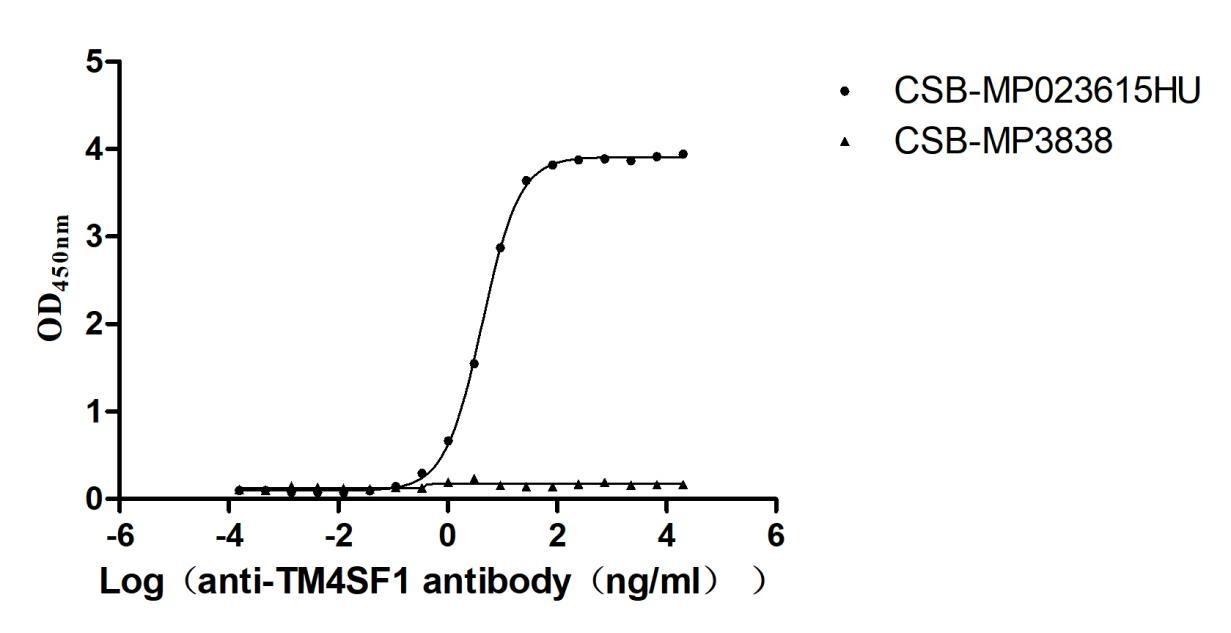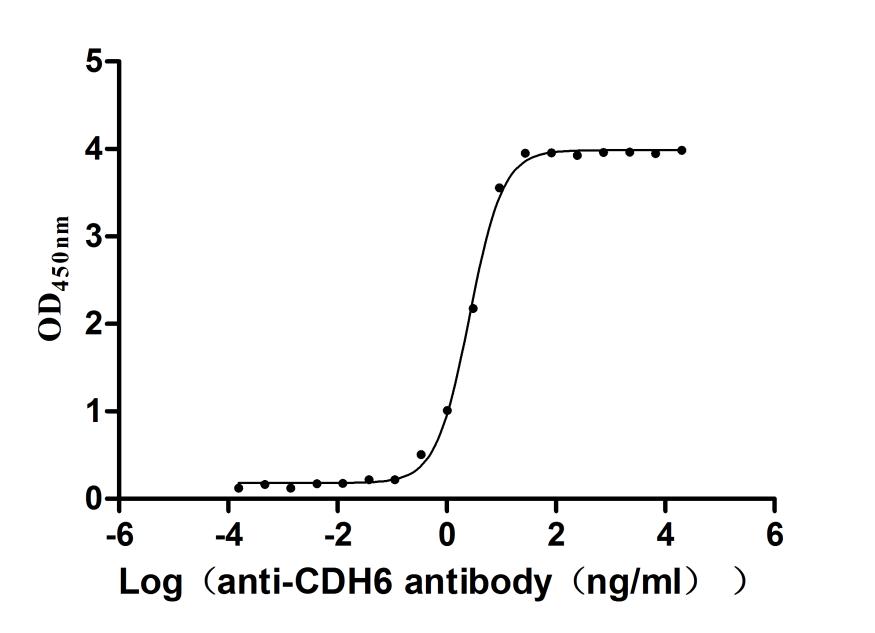Recombinant Mouse Polycomb protein EED (Eed)
-
中文名称:小鼠Eed重组蛋白
-
货号:CSB-YP856362MO
-
规格:
-
来源:Yeast
-
其他:
-
中文名称:小鼠Eed重组蛋白
-
货号:CSB-EP856362MO
-
规格:
-
来源:E.coli
-
其他:
-
中文名称:小鼠Eed重组蛋白
-
货号:CSB-EP856362MO-B
-
规格:
-
来源:E.coli
-
共轭:Avi-tag Biotinylated
E. coli biotin ligase (BirA) is highly specific in covalently attaching biotin to the 15 amino acid AviTag peptide. This recombinant protein was biotinylated in vivo by AviTag-BirA technology, which method is BriA catalyzes amide linkage between the biotin and the specific lysine of the AviTag.
-
其他:
-
中文名称:小鼠Eed重组蛋白
-
货号:CSB-BP856362MO
-
规格:
-
来源:Baculovirus
-
其他:
-
中文名称:小鼠Eed重组蛋白
-
货号:CSB-MP856362MO
-
规格:
-
来源:Mammalian cell
-
其他:
产品详情
-
纯度:>85% (SDS-PAGE)
-
基因名:Eed
-
Uniprot No.:
-
别名:EedPolycomb protein EED
-
种属:Mus musculus (Mouse)
-
蛋白长度:Full Length of Mature Protein
-
表达区域:2-441
-
氨基酸序列SEREVSTAP AGTDMPAAKK QKLSSDENSN PDLSGDENDD AVSIESGTNT ERPDTPTNTP NAPGRKSWGK GKWKSKKCKY SFKCVNSLKE DHNQPLFGVQ FNWHSKEGDP LVFATVGSNR VTLYECHSQG EIRLLQSYVD ADADENFYTC AWTYDSNTSH PLLAVAGSRG IIRIINPITM QCIKHYVGHG NAINELKFHP RDPNLLLSVS KDHALRLWNI QTDTLVAIFG GVEGHRDEVL SADYDLLGEK IMSCGMDHSL KLWRINSKRM MNAIKESYDY NPNKTNRPFI SQKIHFPDFS TRDIHRNYVD CVRWLGDLIL SKSCENAIVC WKPGKMEDDI DKIKPSESNV TILGRFDYSQ CDIWYMRFSM DFWQKMLALG NQVGKLYVWD LEVEDPHKAK CTTLTHHKCG AAIRQTSFSR DSSILIAVCD DASIWRWDRL R
-
蛋白标签:Tag type will be determined during the manufacturing process.
The tag type will be determined during production process. If you have specified tag type, please tell us and we will develop the specified tag preferentially. -
产品提供形式:Lyophilized powder
Note: We will preferentially ship the format that we have in stock, however, if you have any special requirement for the format, please remark your requirement when placing the order, we will prepare according to your demand. -
复溶:We recommend that this vial be briefly centrifuged prior to opening to bring the contents to the bottom. Please reconstitute protein in deionized sterile water to a concentration of 0.1-1.0 mg/mL.We recommend to add 5-50% of glycerol (final concentration) and aliquot for long-term storage at -20℃/-80℃. Our default final concentration of glycerol is 50%. Customers could use it as reference.
-
储存条件:Store at -20°C/-80°C upon receipt, aliquoting is necessary for mutiple use. Avoid repeated freeze-thaw cycles.
-
保质期:The shelf life is related to many factors, storage state, buffer ingredients, storage temperature and the stability of the protein itself.
Generally, the shelf life of liquid form is 6 months at -20°C/-80°C. The shelf life of lyophilized form is 12 months at -20°C/-80°C. -
货期:Delivery time may differ from different purchasing way or location, please kindly consult your local distributors for specific delivery time.Note: All of our proteins are default shipped with normal blue ice packs, if you request to ship with dry ice, please communicate with us in advance and extra fees will be charged.
-
注意事项:Repeated freezing and thawing is not recommended. Store working aliquots at 4°C for up to one week.
-
Datasheet :Please contact us to get it.
靶点详情
-
功能:Polycomb group (PcG) protein. Component of the PRC2/EED-EZH2 complex, which methylates 'Lys-9' and 'Lys-27' of histone H3, leading to transcriptional repression of the affected target gene. Also recognizes 'Lys-26' trimethylated histone H1 with the effect of inhibiting PRC2 complex methyltransferase activity on nucleosomal histone H3 'Lys-27', whereas H3 'Lys-27' recognition has the opposite effect, enabling the propagation of this repressive mark. The PRC2/EED-EZH2 complex may also serve as a recruiting platform for DNA methyltransferases, thereby linking two epigenetic repression systems. Genes repressed by the PRC2/EED-EZH2 complex include HOXA7, HOXB6 and HOXC8. Plays a role in X chromosome inactivation (XCI), in which one of the two X chromosomes in female mammals is transcriptionally silenced to equalize X-linked gene dosage with XY males. Required for stable maintenance of XCI in both embryonic and extraembryonic tissues. May prevent transcriptional activation of facultative heterochromatin during differentiation. Required for development of secondary trophoblast giant cells during placental development. May regulate hippocampal synaptic plasticity in the developing brain.
-
基因功能参考文献:
- Eed, an essential subunit of PRC2, is crucial to maintain the identity of CD4(+) T cells under TGFbeta-induced regulatory T cell (Treg)-polarizing conditions. PMID: 29310022
- Eed deficiency in chondrocytes causes severe kyphosis and a growth defect with decreased chondrocyte proliferation, accelerated hypertrophic differentiation and cell death with reduced Hif1a expression PMID: 27329220
- The progenitors in Eed mutant mice that were induced to differentiate did not develop into properly formed nephrons. Lhx1, normally expressed in the renal vesicle, was overexpressed in kidneys of Eed mutant mice. Thus, PRC2 has a crucial role in suppressing the expression of genes that maintain the progenitor state, allowing nephron differentiation to proceed. PMID: 29945864
- discovery of differentiation stage-specific and dose-dependent roles of EED in normal hematopoiesis and leukemogenesis PMID: 27432459
- our work provides in vivo evidence that the structural integrity of EED to H3K27me3 propagation is critical, especially for embryonic development and hematopoietic homeostasis, and that its perturbation increases the predisposition to hematologic malignancies PMID: 27578866
- Deletion of Eed but not Ezh2 from embryonic urothelial progenitors caused premature differentiation of Krt5+ basal cells and ectopic expression of squamous cell markers. PMID: 28049658
- in the skin epithelium, EED, Suz12, and Ezh1/2 function largely as subunits of the PRC2 complex and have roles in skin development PMID: 26994968
- EED is required for proper erythropoiesis and for formation of hematopoietic progenitor and stem cells, but is dispensable for endothelial lineage commitment and early vascular patterning PMID: 28406475
- Genetic inactivation of Ezh2 or Eed cooperates with NRASQ61K in leukemogenesis. PMID: 26904942
- EED affects the lymphoid versus myeloid decision processes within the lymphomyeloid lineage PMID: 25961873
- Inactivation of Eed impedes MLL-AF9-mediated leukemogenesis through Cdkn2a-dependent and Cdkn2a-independent mechanisms in a murine model. PMID: 26118502
- Data suggest that Eed (embryonic ectoderm development) is necessary to silence the pluripotency network during differentiation. PMID: 25134795
- An integral role for EED as an epigenetic exchange factor coordinating the activities of PRC1 and 2, is reported. PMID: 24457600
- a microRNA encoded by the imprinted Dlk1-Dio3 region of mouse chromosome 12, miR-323-3p, targets Eed (embryonic ectoderm development) mRNA. PMID: 23821546
- Ectopic gain of EED along with depletion of KDM6B in preimplantation mouse embryos abrogates CDX2 and GATA3 gene expression in the nascent trophoectoderm lineage. PMID: 23671187
- It was shown that Ring1B interacted with multiple complexes in embryonic stem cells. Although H2A.Z co-localized with Eed, Ring1B and CpG islands in chromatin, H2A.Z still blanketed polycomb target loci in the absence of Suz12, Eed, or Ring1B. PMID: 22496869
- Data indicate that binding of EZH2, SUZ12 and EED, the 3 subunits of Plybomb repressive complex 2 (PRC2), is required for PRC2 full activity, and late during viral infection, a significant increase in PRC2 protein association with chromatin. PMID: 22279536
- The role of polycomb repressive complex 2 (PRC2) function in leukemia development and progression, is reported. PMID: 22396593
- identify polycomb-like 2 and Polycomb Repressive Complex 2 transcriptional targets and draft regulatory networks.[Polycomb Repressive Complex 2 and polycomb-like 2] PMID: 20144788
- Embryonic cells homozygous for a null mutation were shown to respond properly to gastrulation signals, but failed to differentiate into forebrain and also segregated themselves from normal cells in the somites. PMID: 11783004
- Eed and a second Polycomb group protein, Enx1, are directly localized to the inactive X chromosome in XX trophoblast stem (TS) cells PMID: 12123576
- The anterior expression boundaries of several Hox genes were shifted rostrally by one segment, indicating that Eed is required for stable repression of homeotic genes. PMID: 12370779
- Eed is a member of a new class of trans-acting factors that regulate parent-of-origin expression at imprinted loci PMID: 12627233
- Eed has a role in genetic imprinting in mice [review] PMID: 12665859
- Eed is required for global histone H3 lysine-27 methylation. PMID: 15916951
- Results demonstrate that the inactive X-chromosome in Eed(-/-) trophoblast stem cells and in cells of the trophectoderm-derived extra-embryonic ectoderm in Eed(-/-) embryos remain transcriptionally silent. PMID: 16415857
- EED is dispensable for the initiation of random X-chromosome inactivation PMID: 16680199
- Eed associates with the trxG protein Mll upon brain maturation. PMID: 17259173
- These results suggest a common mechanism for random monoallelic expression on autosomes and the X chromosome, and implicate Eed in establishing differences between homologous olfactory receptor loci before and after differentiation. PMID: 17954609
- core WD-40 motifs and the histone-binding region of EED alone are sufficient for the generation of all three marks, demonstrating that EED isoforms do not control the number of methyl groups added to H3K27 PMID: 17997413
- STAT3 and Oct-3/4 maintain silencing of differentiation-associated genes through up-regulation of Eed in self-renewing ES cells. PMID: 18201968
- Deficiency for the Polycomb group protein EED, leads to biallelic expression of Tfpi2 in the extra-embryonic lineages, whereas the other genes in the cluster maintain correct imprinting. PMID: 18480470
- Male embryonic stem cells with Eed-null and Tsix mutations (X(Delta)Y Eed-/-) showed Xist hyperactivation upon differentiation, whereas cells with either mutation alone did not. PMID: 18511907
- Eed are significantly downregulated during murine skin repair. PMID: 19575012
显示更多
收起更多
-
亚细胞定位:Nucleus. Chromosome. Note=Localizes to the inactive X chromosome in cells of the early embryo and in stem cells of the extraembryonic trophectoderm lineage. Recruitment to the inactive X-chromosome requires XIST.
-
蛋白家族:WD repeat ESC family
-
组织特异性:Expressed in brain, heart, kidney, liver, lung, muscle, ovary, spleen and testis. Expressed throughout the brain.
-
数据库链接:
KEGG: mmu:13626
STRING: 10090.ENSMUSP00000102853
UniGene: Mm.380914
Most popular with customers
-
Recombinant Severe acute respiratory syndrome coronavirus 2 Spike glycoprotein (S), partial (Active)
Express system: Mammalian cell
Species: Severe acute respiratory syndrome coronavirus 2 (2019-nCoV) (SARS-CoV-2)
-
Recombinant Human Glucagon receptor (GCGR), partial (Active)
Express system: Mammalian cell
Species: Homo sapiens (Human)
-
Recombinant Human Claudin-9 (CLDN9)-VLPs (Active)
Express system: Mammalian cell
Species: Homo sapiens (Human)
-
Recombinant Macaca fascicularis CUB domain containing protein 1 (CDCP1), partial (Active)
Express system: Mammalian cell
Species: Macaca fascicularis (Crab-eating macaque) (Cynomolgus monkey)
-
Recombinant Human Transmembrane 4 L6 family member 1(TM4SF1)-VLPs (Active)
Express system: Mammalian cell
Species: Homo sapiens (Human)
-
Recombinant Human Cadherin-6(CDH6),partial (Active)
Express system: Mammalian cell
Species: Homo sapiens (Human)


